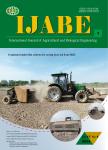Improving energy efficiency of apple production by reduced application of pesticides
作者机构:University of Novi SadFaculty of AgricultureTrg Dositeja Obradovića 821000 Novi SadSerbia University of Novi SadFaculty of TechnologyBlv.Cara Lazara 121000 Novi SadSerbia
出 版 物:《International Journal of Agricultural and Biological Engineering》 (国际农业与生物工程学报(英文))
年 卷 期:2020年第13卷第4期
页 面:93-102页
核心收录:
学科分类:0202[经济学-应用经济学] 02[经济学] 020205[经济学-产业经济学]
基 金:This paper was supported by Ministry of Education Science and Technology Development of Republic of Serbia(No.451-03-68/2020-14/200117)
主 题:apple production energy flow pesticide application rates total energy input energy balancing
摘 要:A large number of apple orchards are treated over 20 times during the vegetation period with high application rates(over 1000 L/hm^(2))or medium application rates(500-1000 L/hm^(2))of pesticides which require significant energy *** research was carried out in the Serbian region of Vojvodina with the aim to show the possibilities to reduce energy usage in apple production by reducing pesticide application rates(200-500 L/hm^(2))and smaller controlled number of treatments with pesticides while maintaining the biological efficiency of apple chemical *** results showed that the cumulative life cycle energy demand of apple production in Vojvodina,assuming a typical 22 annual treatments and relatively high pesticide application rate(1150 L/hm^(2)),was 48 GJ/hm^(2)and energy output was 94 GJ/hm^(2).Reduced number of treatments and lower pesticide application rates have a favorable impact on energy inputs associated with diesel fuel,machinery,chemicals,water and electricity consumption and usage,whereas other energy inputs remain *** energy input for 12 treatments with pesticide application rates of 381 L/hm^(2)was 36 GJ/hm^(2),which is a 25%reduction in comparison to 22 treatments with a pesticide application rate of 1150 L/hm^(2).Reduced number of treatments and pesticide application rate increased the energy use efficiency from 1.96 to 2.61,energy productivity from 0.82 kg/MJ to 1.09 kg/MJ,and net energy from 46 GJ/hm^(2)to 58 GJ/hm^(2).Results also suggest that applying the correct IPM approach can easily lead to a strong reduction in the number of treatments and a major energy saving.



